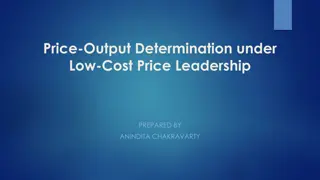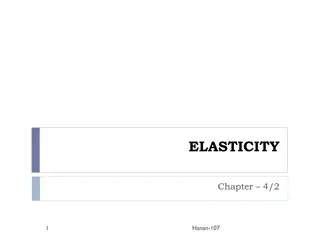Understanding the Allocation Problem and Price Mechanism in Economics
Delve into the concepts of the allocation problem and price mechanism in economics through a series of exercises and discussions, exploring topics like Pareto efficiency, opportunity cost, supply and demand curves, and societal welfare maximization. An engaging example involving the rental of a scanner at a hospital highlights the complexity of decision-making in resource allocation scenarios. Additionally, a real-life scandal involving traffic manipulation sheds light on the consequences of misallocated resources.
Download Presentation

Please find below an Image/Link to download the presentation.
The content on the website is provided AS IS for your information and personal use only. It may not be sold, licensed, or shared on other websites without obtaining consent from the author. Download presentation by click this link. If you encounter any issues during the download, it is possible that the publisher has removed the file from their server.
E N D
Presentation Transcript
The Allocation Problem and the Price Mechanism Economic Problems and Policy Analysis Helios Herrera January 2014
Plan of the day Today Little refresh of Pareto Efficiency Allocation problem and Price Mechanism Exercises
After this session The Allocation Problem: Opportunity cost and marginal rate of substitution Production possibilities frontier and resource scarcity Maximazion of well-being under resource constraints Impact of technological change The Price Mechanism: How demand curve reveals preferences How the supply curve represents the marginal cost of production Consumers and producers surpluses Discuss the roles of price mechanism
Maximizing Societys Welfare Let s go back to last week s lecture In order to maximize a group s welfare, it must be impossible to increase someone s welfare without decreasing someone else s welfare In an efficient allocation of goods, no one can be made better off without making someone else worse off Examples: Classrooms, smoking, etc..
An example The CHUM proposes to rent its very expensive scanner: At a good price to private companies Between 4pm and 9pm Note: this is no working time for CHUM
Renting out the scanner Patients at CHUM R2 R0 R1 What is the most plausible scenario? 1. R0 R1 2. R0 R2 3. R2 R1 Let s vote! Satisfaction of other patients
Renting out the scanner Patients at CHUM R2 R0 R1 What is the most plausible scenario? 1. R0 R1 2. R0 R2 3. R2 R1 Let s vote! Satisfaction of other patients
Chris Christie A bridge too far? A scandal threatens the New Jersey governor s nice-thug image In September the Port Authority closed two lanes of traffic on a bridge that links New Jersey with Manhattan for a so-called traffic study . The weeklong traffic jam that resulted was hardest on commuters in Fort Lee, a nearby suburb run by Mark Sokolich, a Democrat who refused to endorse Mr Christie in the election. Besides being a nuisance, the gridlock also reportedly kept ambulances from reaching an unconscious 91-year- old woman, who later died. State Democrats cried foul. On January 8th they found their smoking gun: e-mails from Bridget Anne Kelly, a senior Christie staffer, to the governor s friends at the Port Authority signalling the closures. Time for some traffic problems in Fort Lee, she wrote.
Conditions to Maximize Social Welfare Let s start with a practical example: vanilla ice cream and chocolate ice cream. In order to maximize consumers welfare, 3 conditions must be met:
Three conditions Make sure that: 1. No resources are wasted and that as much ice cream as possible is produced with available ressources 2. The flavor mix best corresponds to consumers preferences 3. Each flavor goes to the consumers that like them most
Discussion Think about last week s discussion Is it possible to maximize welfare if one of these conditions is transgressed ? Is it possible to increase someone s welfare without decreasing someone else ?
Maximizing Societys Welfare, 1 In talking about maximizing social welfare, economists have in mind 3 different optimality concepts : Efficiency in Production Efficiency in Output Efficiency in Exchange
Maximizing Societys Welfare, 2 Efficiency in production The only way to increase production of a good is to decrease production of another Conditions: using inputs efficiently in the production process (isoquants, isocosts, MRTS) Right combinations of inputs All inputs (no wasting)
Maximizing Societys Welfare, 3 Efficiency in output Output (goods) must be produced in combinations that match people s preferences The mix of outputs must be chosen so that any other mix must reduce someone s welfare
Maximizing Societys Welfare, 4 Efficiency in exchange Whatever the output, its distribution must be efficient Each good must be consumed by the person who values it most ! Consumers must thus be able to complete all mutually beneficial trades Ex: hockey tickets
Efficiency in exchange Difficult concept Unrelated to value judgments about rich and poor If A is ready to pay $250 for a ticket and B is ready to pay $100, A should get the ticket! Explanation: voluntary exchanges can only benefit both parties to the exchange Exceptions: limited information
The Allocation Problem All the preceding discussion turned around the allocation problem For most people, only distribution problems exist Ex: rent controls, minimum wage Most economic changes have distributive and allocative effects
Illustration of an Allocation Problem The production possibility curve (PPC) The basic problem of every society is that resources are rare and needs are unlimited Choices must therefore be made: Which goods to produce ? Which wants to satisfy ?
The PPC Society s production possibility curve (or Frontier) Society s budget curve Full employment and the PPC
Production Possibility Curve (PPC) A Canons F.. C E B Schools
PPC and Opportunity Costs The production possibility frontier and opportunity costs Opportunity costs are the sacrifice society must make in order to produce more of a good Opportunity costs and costs of production Opportunity costs and the PPC On the PPC Inside the PPC
Increasing marginal costs Resource specialization and diminishing marginal returns Consequences on the shape of the PPC
PPC with specialized resources A Canons B A concave PPC C D XA+ 1 XA Schools XC XC+ 1
Increasing marginal costs Compare the cost of production of one extra unit of Coconuts 1. The cost in E3 is bigger than in E7 The cost in E3 is smaller than in E7 The costs are identical Let s vote! 2. 3.
Increasing marginal costs Compare the cost of production of one extra unit of Coconuts 1. The cost in E3 is bigger than in E7 The cost in E3 is smaller than in E7 The costs are identical Let s vote! 2. 3.
Applications The effects of technological change on the PPC The effects of an earthquake on the PPC The effects of an increase in productivity on the PPC Change of slope and opportunity costs
Technological change in the production of canons C1 Canons C0 Schools
Consumers Preferences Definition of social indifference curves
Compare the value of a extra unit of Coconuts if we are in E1 to the value of one extra unit of Coconuts in we are in E2 1. Value in E1 is greater than E3 Value in E1 is smaller than E3 Value in E1 is the same as E3 2. 3. Let s Vote! Hint: use the slopes
Compare the value of a extra unit of Coconuts if we are in E1 to the value of one extra unit of Coconuts in we are in E2 1. Value in E1 is greater than E3 Value in E1 is smaller than E3 Value in E1 is the same as E3 2. 3. Let s Vote! Hint: use the slopes
With the following preferences, we observe that 1. E4 gives less utility than E2 The value of coconuts in E1 is greater than than the value in E5 E4 and E5 give the same value 2 and 3 are true 2. 3. 4. Let s Vote!
With the following preferences, we observe that 1. E4 gives less utility than E2 The value of coconuts in E1 is greater than than the value in E5 E4 and E5 give the same value 2 and 3 are true 2. 3. 4. Let s Vote!
Pareto Efficiency Definition: 3 necessary optimums Applications Problem: absence of unanimity There exists no economic solution to the distribution problem (meaning what is the best distribution of revenues).
Why allocation E*maximizes social welfare ? 1. It is on the highest indifference curve The value of a Coconuts is the same as its production cost All resources are used 1+2+3 are true 2. 3. 4. Let s vote!
Why allocation E*maximizes social welfare ? 1. It is on the highest indifference curve The value of a Coconuts is the same as its production cost All resources are used 1+2+3 are true 2. 3. 4. Let s vote!
The dotted line shows technological progress in fishing. If workers are not mobile between sectors, what can be said about the new equilibrium? 1. Society s welfare will remain unchanged The new production will be at point E2 The new equilibrium will be at point E1 None of the above 2. 3. 4. Let s vote!
The dotted line shows technological progress in fishing. If workers are not mobile between sectors, what can be said about the new equilibrium? 1. Society s welfare will remain unchanged The new production will be at point E2 The new equilibrium will be at point E1 None of the above 2. 3. 4. Let s vote!
The Department of health has decided that hospital scanners cannot be used by private clinics when not in use by hospitals. Identify this situation in the graph. 1. A 2. B 3. C Other goods A B C Healthcare
The Department of health has decided that hospital scanners cannot be used by private clinics when not in use by hospitals. Identify this situation in the graph. 1. A 2. B 3. C Other goods A B C Healthcare
NAFTA at 20 Ready to take off again? Two decades ago the North American Free-Trade Agreement got off to a flying start. Then it stalled PASS through the gates of the Bombardier plant in Quer taro and you leave the Mexico of potholed roads and blaring horns behind: welcome to a strangely serene place called North America. With the exception of the wings, which are made in Northern Ireland, the Learjet 85 is a North American story. Bombardier, a Canadian firm based in Montreal, took over Learjet, an American firm, in 1990. When the Mexico- made carcass reaches Learjet s headquarters in Wichita, Kansas, for kitting out, it is married to engines built in Canada, but designed by America s Pratt & Whitney. It is fitting that the 85 s maiden flight will, all things being equal, come within a few weeks of the 20th anniversary of the North American Free-Trade Agreement coming into force on January 1st 1994. Without NAFTA, a trinational endeavour like the new Learjet would be unthinkable.
Epilogue We must get the most out of our resources (the problem of scarcity) Choices entail costs We must make sure that what we produce is in line with peoples preferences More of a little desired good and less of a highly desired good = decrease in welfare As we will see, unless failures arise, decentralized decisions in markets are efficient
Welfare in Partial Equilibrium Partial Eq.: Market per market vision Tool: surplus Study plan: Surplus and interpretation Market efficiency The roles of prices Inefficient cases
Consumers Surplus Let s suppose a few copies of Elvis last album are put on sale Four buyers seem interested: John is willing to pay 100$ Paul is willing to pay 80$ George is willing to pay 70$ Ringo is willing to pay 50$ Consumers all pay the same price, but do not value goods the same way
Price John s willingness to pay 100 Paul s willingness to pay 80 Georges 70 Ringo 50 Demand 1 2 3 4 Qty
Definitions Willingness to pay: maximum amount a buyer is ready to pay to obtain a good = measure of the value of good to the buyer Voluntary exchange Consumer surplus: difference between the willingness to pay and the price really paid for the good
Price Price = $80 100 John s consumer surplus ($20) Paul 80 Georges 70 Ringo 50 1 2 3 4 Qty
Price Price = $70 100 John s consumer surplus ($30) 80 Paul s consumer surplus (10$) Georges 70 Ringo 50 Total CS = $40 1 2 3 4 Qty
Continuous Case Price Consumer Surplus The lower the price, the higher the consumer surplus P1 P2 D Q2 Q1 Qty
Consumer surplus: measure of welfare CS = (willingness to pay price paid) CS measures, from the buyer s point of view, the surplus benefit received when buying a good CS is a good measure of the welfare consumers get when consuming a good























